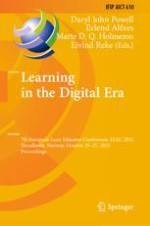2021 | Book
Learning in the Digital Era
7th European Lean Educator Conference, ELEC 2021, Trondheim, Norway, October 25–27, 2021, Proceedings
Editors: Daryl John Powell, Dr. Erlend Alfnes, Marte D. Q. Holmemo, Eivind Reke
Publisher: Springer International Publishing
Book Series : IFIP Advances in Information and Communication Technology
